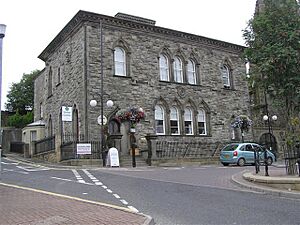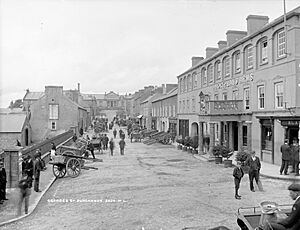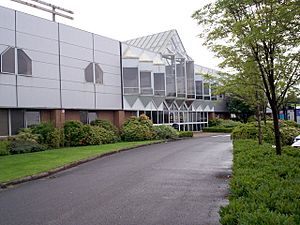Dungannon facts for kids
Quick facts for kids Dungannon
|
|
|---|---|
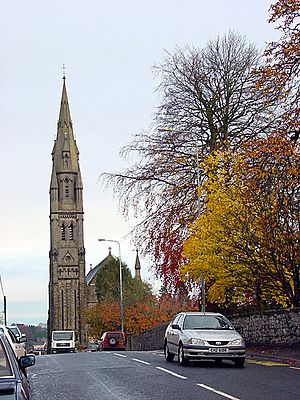 St Patrick's Roman Catholic church |
|
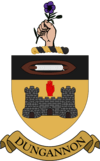 Dungannon Coat of Arms |
|
| Population | 16,282 (2021 Census) |
| Irish grid reference | H7962 |
| • Belfast | 40 miles (64 km) |
| District |
|
| County | |
| Country | Northern Ireland |
| Sovereign state | United Kingdom |
| Post town | DUNGANNON |
| Postcode district | BT70, BT71 |
| Dialling code | 028 |
| Police | Northern Ireland |
| Fire | Northern Ireland |
| Ambulance | Northern Ireland |
| EU Parliament | Northern Ireland |
| UK Parliament |
|
| NI Assembly |
|
Dungannon is a lively town in County Tyrone, Northern Ireland. Its name comes from the Irish words Dún Geanainn, which means "Geanann's fort." It's the second-largest town in County Tyrone, right after Omagh. In 2021, about 16,282 people lived there.
For many centuries, Dungannon was the main home of the powerful O'Neill dynasty. These leaders ruled much of Ulster and built a strong castle on a hill in the town. After the O'Neills were defeated in a big war, the English started a new settlement there. This settlement grew into the Dungannon we know today. Dungannon has even won the "Ulster in Bloom's Best Kept Town Award" five times! It's also known for having a high number of people who have moved there from other countries.
Contents
History of Dungannon
For hundreds of years, Dungannon was very important to the O'Neill dynasty. They were a powerful family who ruled a large part of Ulster until the 1600s. Dungannon was their main base. The O'Neills built a castle on what is now called Castle Hill. This spot was perfect for a fort because it was one of the highest points around. From there, they could see far across the countryside.
In 1602, the castle was burned down by Hugh O'Neill, 2nd Earl of Tyrone. This happened as English forces were closing in during the Nine Years' War. A few years later, in 1607, many Irish leaders, including Hugh O'Neill, left Ireland. This event is known as the Flight of the Earls. After they left, the English started the Plantation of Ulster. This meant new settlers came to live on the land. Dungannon and its castle were given to Sir Arthur Chichester, who helped plan the Plantation.
In 1641, during the Irish Rebellion, Sir Phelim O'Neill took control of Dungannon. He then issued the Proclamation of Dungannon. In this message, the rebels explained their goals and said they were loyal to King Charles I.
Archaeologists explored part of the old castle in October 2007 for the TV show Time Team. They found parts of the castle's moat and walls. In 1782, an important event happened in Dungannon. Members of the Irish Parliament declared that the parliament should be independent.
The Civil Rights Movement
In the late 1960s, Northern Ireland faced a period of conflict known as the Troubles. During this time, there were many challenges in and around Dungannon. On August 24, 1968, a very important event took place. Groups like the Campaign for Social Justice (CSJ) and the Northern Ireland Civil Rights Association (NICRA) held Northern Ireland's first civil rights march. It went from Coalisland to Dungannon. Even though the march was officially banned, it happened peacefully. This march helped inspire other groups to form and work for civil rights.
People of Dungannon
The number of people living in Dungannon grew steadily during the 1800s.
| Year | 1841 | 1851 | 1861 | 1871 | 1881 | 1891 |
|---|---|---|---|---|---|---|
| Population | 3,801 | 3,854 | 3,994 | 3,886 | 4,084 | 3,812 |
| Houses | 675 | 686 | 720 | 727 | 812 | 830 |
Dungannon in 2011
In 2011, Dungannon had 14,340 people living there. This was a big increase of over 30% from 2001, making it one of the fastest-growing towns in Northern Ireland. It also has the highest percentage of immigrants of any town in Northern Ireland. About 11% of its population were immigrants, which is more than twice the average. Many people moved to Dungannon to work in the local food processing factories.
Here are some facts from the 2011 Census:
- About 22% of people were under 16 years old.
- About 12% of people were 65 or older.
- Over 64% of people were Catholic Christians.
- Over 30% of people were Protestant or other Christians.
- About 31% felt they had an Irish national identity.
- About 28% felt they had a British national identity.
- About 23% felt they had a Northern Irish national identity.
- The average age was 34 years.
- About 15% knew some Irish (Gaelic).
- About 4% knew some Ulster-Scots.
- About 23% did not have English as their first language.
Dungannon in 2021
| National Identity of Dungannon residents (2021) | ||||
|---|---|---|---|---|
| Nationality | Per cent | |||
| Irish | 27.2% | |||
| British | 22.0% | |||
| Northern Irish | 19.6% | |||
In the 2021 Census, Dungannon's population grew to 16,282 people. This was a 13.5% increase from 2011.
Here are some interesting facts from the 2021 Census:
- About 34.85% of the town's population was born outside the United Kingdom and Ireland. This is the highest percentage in Northern Ireland!
- The largest groups of foreign-born people are from East Timor (1,777 people), Lithuania (1,565 people), Poland (717 people), and Portugal (578 people).
- About 67% of the population were Catholic Christians.
- About 24% were Protestant or other Christians.
- About 22% were under 16 years old.
- About 12% were 65 or older.
- About 15% knew some Irish.
- About 6% knew some Ulster-Scots.
- About 31% did not have English as their first language.
- About 27% had an Irish national identity.
- About 21% had a British national identity.
- About 19% had a Northern Irish national identity.
| Religion or religion brought up in | Number | (%) |
|---|---|---|
| Catholic: Total | 10,934 | 67.15 |
| Catholic: British/Irish/Northern Irish/English/Scottish/Welsh (with or without non-UK or Irish national identities) | 6,117 | 37.57 |
| Catholic: Other | 4,817 | 29.58 |
| Protestant and Other Christian: Total | 3,950 | 24.25 |
| Protestant/Other Christian: British/Irish/Northern Irish/English/Scottish/Welsh (with or without non-UK or Irish national identities) | 3,534 | 21.70 |
| Protestant/Other Christian: Other | 416 | 2.55 |
| Other religions: Total | 265 | 1.63 |
| Other religions: British/Irish/Northern Irish/English/Scottish/Welsh (with or without non-UK or Irish national identities) | 114 | 0.70 |
| Other religions: Other | 151 | 0.93 |
| None: Total | 1,134 | 6.96 |
| None: British/Irish/Northern Irish/English/Scottish/Welsh (with or without non-UK or Irish national identities) | 441 | 2.71 |
| None: Other | 693 | 4.25 |
| Total | 16,282 | 100.00 |
| Ethnic group | Number | (%) |
|---|---|---|
| White: Total | 13,032 | 80.04 |
| White: British/Irish/Northern Irish/English/Scottish/Welsh (with or without non-UK or Irish national identities) | 9,393 | 57.69 |
| White: Other | 3,487 | 21.42 |
| White: Irish Traveller | 118 | 0.72 |
| White: Roma | 35 | 0.21 |
| Black or Black British: Total | 1,267 | 7.78 |
| Black/Black British: Black African | 341 | 2.09 |
| Black/Black British: Black Other | 926 | 5.69 |
| Asian or Asian British: Total | 1,182 | 7.26 |
| Asian/Asian British: Other Asian | 959 | 5.89 |
| Asian/Asian British: Chinese | 86 | 0.53 |
| Asian/Asian British: Indian | 76 | 0.47 |
| Asian/Asian British: Arab | 33 | 0.20 |
| Asian/Asian British: Filipino | 20 | 0.12 |
| Asian/Asian British: Pakistani | 8 | 0.05 |
| Mixed: Total | 641 | 3.94 |
| Other: Any other ethnic group: Total | 160 | 0.98 |
| Total | 16,282 | 100.00 |
| Country of birth | Number | (%) |
|---|---|---|
| United Kingdom and Ireland | 10,607 | 65.15 |
| Northern Ireland | 9,890 | 60.74 |
| England | 389 | 2.39 |
| Scotland | 61 | 0.37 |
| Wales | 9 | 0.06 |
| Republic of Ireland | 258 | 1.58 |
| Europe | 3,336 | 20.49 |
| European Union | 3,272 | 20.10 |
| European Union: Lithuania | 1,565 | 9.61 |
| European Union: Poland | 717 | 4.40 |
| European Union: Portugal | 578 | 3.55 |
| European Union: Other EU countries | 412 | 2.53 |
| Other non-EU countries | 64 | 0.39 |
| Rest of World | 2,339 | 14.37 |
| Middle East and Asia | 1,996 | 12.26 |
| Middle East/Asia: East Timor | 1,777 | 10.91 |
| Middle East/Asia: Other | 219 | 1.35 |
| Africa | 223 | 1.37 |
| South America | 75 | 0.46 |
| North America, Central America and Caribbean | 36 | 0.22 |
| Antarctica, Oceania and Other | 9 | 0.06 |
| Total | 16,282 | 100.00 |
Places to Visit
One interesting building in Dungannon is the old police barracks. It's at the corner of the market square. People often tell a fun story that its unique design is because the building plans got mixed up in Dublin. They say Dungannon got plans meant for Nepal, and Nepal got a standard Irish police station!
Dungannon Park is a large park covering about 70 acres. It has a beautiful lake in the middle, with many paths for walking. You can also enjoy views of the surrounding area from the park.
Geography of Dungannon
Dungannon is located in the southeastern part of County Tyrone. It sits within the historic area called the barony of Dungannon Middle. The town grew up around a hill known as Castle Hill.
On the southern edge of town, there are three small lakes. The biggest one is called Black Lough. There are also two parks in the eastern part of town: Dungannon Park and Windmill Park. Nearby villages include Moygashel, Coalisland, Donaghmore, and Castlecaulfield.
Townlands in Dungannon
Dungannon first started in a place called Drumcoo. Over time, the town grew and spread into nearby areas called townlands. Many roads and housing estates in Dungannon are named after these townlands. Here are some of them and what their names might mean:
- Ballynorthland Park
- Ballysaggart (from Baile Sagairt, meaning "homestead of the priest")
- Coolhill (from Cúlchoill, meaning "the back woods")
- Drumcoo (from Druim Cuaiche, meaning "ridge of the cuckoo")
- Drumharriff (from Druim Thairbh, meaning "ridge of the bull")
- Gortmerron (from Gort Mearain, meaning "Merron's field")
- Killymaddy (from Coill na Madaí, meaning "wood of the dogs")
- Killymeal (from Coill na Maoile, meaning "wood of the bald/hornless cow")
- Lisnaclin (from Lios na Clinge, meaning "ringfort of the bell chime")
- Lisnahull (from Lios na hOlna, meaning "ringfort of the wool")
- Lurgaboy (from Lurga Buí, meaning "yellow shin," referring to a shin-shaped hill)
- Mullaghadun (from Mullach a' Dúin, meaning "hilltop of the fort")
- Mullaghanagh (from Mullach Eanach, meaning "marshy hilltop")
- Mullaghconor (from Mullach Chonchobhair, meaning "Conchobhair's hilltop")
- Mullaghmore (from Mullach Mór, meaning "big hilltop")
Economy
For many years, the famous crystal glass maker Tyrone Crystal was based in Dungannon. However, it closed down in 2010.
Schools in Dungannon
Dungannon has many schools for different age groups.
- Primary Schools
- Aughamullan (Holy Family) Primary School (RC)
- Bush Primary School
- Clintyclay Primary School
- Derrylatinee Primary School (RC)
- Donaghey Controlled Primary School
- Dungannon Primary School
- Killyman Primary School
- Laghey Primary School (RC)
- Lisfearty Primary School
- Newmills Primary School
- Orchard County Primary School (a combination of Annaghmore and Tullyroan primary schools)
- St Mary's Primary School
- St Patrick's Primary School
- Tamnamore Primary School
- Walker Memorial Primary School
- Windmill Integrated Primary School
- Secondary Schools
- Royal School Dungannon
- Integrated College Dungannon
- St Patrick's Academy, Dungannon
- Drumglass High School
- St Patricks's College, Dungannon
Transport
Dungannon is connected to the M1 motorway, which runs from the southeast of the town all the way to Belfast. There is a local bus service called Ulsterbus that helps people get around the town's different areas every day. The closest train station is at Portadown, which is part of the Northern Ireland Railways network.
Old Railways
Dungannon used to have its own railway station. The Portadown, Dungannon and Omagh Junction Railway (PD&O) connected the town to Portadown starting in 1858 and to Omagh from 1861. This completed a railway route from Portadown to Derry. The Great Northern Railway took over the PD&O in 1876. They also built a branch line from Dungannon to Cookstown in 1879.
However, over time, parts of the railway closed down. The Cookstown branch was shortened in 1956 and then closed completely in 1959. The main line through Dungannon also closed in 1965. Today, the old site of Dungannon station is a public park, and the former train tracks are now a greenway for walking and cycling.
Famous People from Dungannon
Many notable people have come from Dungannon:
Born in the 1800s
- Thomas J. Clarke (1858–1916) – He was the first person to sign the Proclamation of the Irish Republic in 1916.
- Richard Dowse (1824–1890) – A judge.
- Sister Nivedita (born Margaret Elizabeth Noble) (1867–1911) – A social worker, author, and teacher.
- George T. Oliver (1848–1919) – A U.S. Senator.
- Henry W. Oliver (1840–1904) – A well-known industrialist from Pittsburgh.
Born in the 1900s
- Birdy Sweeney (1931-1999) - An actor.
- Austin Currie (born 1939) - A former member of the Parliament of Northern Ireland.
- Victor Sloan (born 1945) - A famous artist.
- Bernadette Devlin McAliskey (born 1947) - A former British Member of Parliament and activist.
- Gerry McKenna (born 1953) - A biologist and former Vice Chancellor of the University of Ulster.
- Dominic Gates (born 1954/1955) - A journalist who won a Pulitzer Prize.
- Adrian Logan (born 1955) - A television presenter.
- Darren Clarke (born 1968) - A professional golfer.
- Patrick Wallace (born 1969) - A snooker player.
- Ryan Farquhar (born 1976) - A motorcycle racer.
- Joanne Salley (born 1977) - A television presenter.
- Kris Meeke (born 1979) - A rally driver.
- Gareth Steenson (born 1984) - A rugby union player.
- Colin Morgan (born 1986) - An actor.
- Niall McGinn (born 1987) - A footballer.
- Fra Fee (born 1987) - A film and stage actor.
Sports in Dungannon
Dungannon is a town that loves sports, with many clubs and activities.
Cricket
Dungannon Cricket Club started way back in 1865. After some breaks, it was reformed in 1948 and still plays today. The club plays its home games at Dungannon Park.
Football
Dungannon Swifts F.C. is the town's local football team. They play in the NIFL Premiership, which is a top league. They are the only team from Tyrone in this league. The club has even represented Northern Ireland in European competitions!
Gaelic Games
Dungannon has also had a lot of success in Gaelic games, including Gaelic football and hurling. Many footballers from Dungannon have played for the Tyrone County Team. This team won the All-Ireland Gaelic Football Championship in 2003, 2005, and 2008.
The local boys' Gaelic football club is Dungannon Thomas Clarkes. The ladies' football team is Aodh a Ruadh. For hurling, the local club is Eoghan Ruadh, Dungannon, and the Camogie club is Naomh Treasa.
Golf
Dungannon Golf Club has an 18-hole course. In January 2022, they appointed their first woman captain, which was a historic moment for the club.
Rugby
Dungannon Rugby FC was founded in 1873. This makes it one of the first towns in Ireland to form a rugby club!
Images for kids
See also
 In Spanish: Dungannon (Irlanda del Norte) para niños
In Spanish: Dungannon (Irlanda del Norte) para niños



